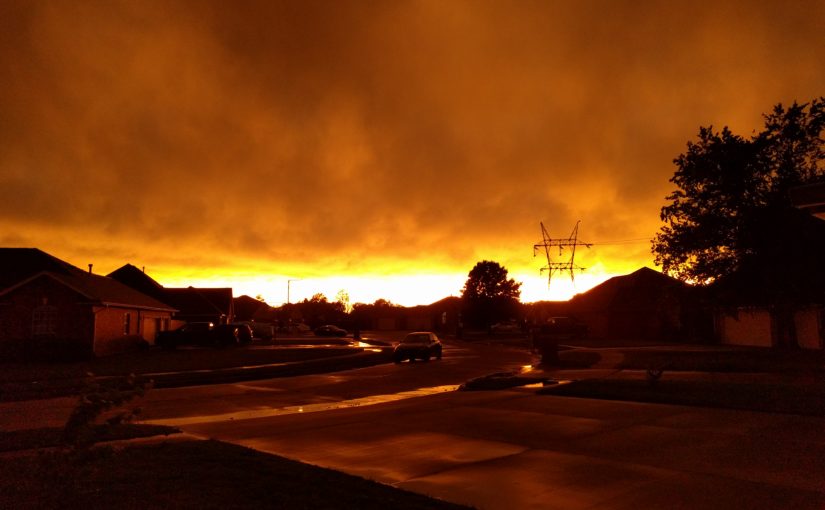Global warming is a much bigger problem (in terms of complexity and danger) than most people realize; while also being a significantly less catastrophic calamity than many zealots claim it is. The problem IS NOT around politics, or will, or capability. From the standpoint of trying to engineer a solution; the problems are known, well understood, and exceptionally difficult. And like any exceedingly complex engineered solution, the problem cannot be resolved at mass scale without significant time.
Universal View
At a fundamental level human beings, by their very nature, use energy to reduce entropy. It doesn’t mater if you are making software, building bridges, teaching students, or cooking dinner. The energy may come from food, firewood, or electricity… but everything we do, as long as we continue to be alive, needs energy. There are only really 3 fundamental components of the universe that humans interact with… space, time, and energy (matter being a form of energy.) Humans can only effectively control one of them… energy.
It is fundamentally impossible for human being to progress without using more and more energy. In a very real sense, energy use IS PROGRESS!
Modernity, or human advancement, or progress if you will; are ALL directly related to humans using MORE energy and using it more effectively. Forget tracking calories per person, or average income per person. Calories come from food that had to be made with energy. Value (in the form of income or goods) comes from energy being used to make them. Think of energy use as the speedometer of human progress. When the dark ages happened in Europe and the economy tanked in 2008, the energy use per person dropped. When the standard of living goes up for a city, or a country, or the planet… the energy use per person almost always increases.
I say almost because efficiency in energy use can lower total energy use in many functions in advanced society. At their core, that is what tools do. People may hate industrialization, but it has allowed a dramatic drop in the amount of energy needed per pound of food. That said, it is never zero; and it can’t be because the only way to overcome entropy is using energy.
So the story of the continual development of humanity is the story of our ability to more effectively use energy to do the work of reducing entropy. In the beginning the only general purpose machine we had for “doing/making” things was the human body. We fed it, and it allowed us to do things. Over time we realized we could “do/make” more by spending some of that energy to make tools that allowed us to use less energy to “do/make” the same amount of work (or even better, more work.) The cycle continued over and over again until we understood enough of the physical world that the ability to make tools was limited only by the amount of energy we could put into those tools to do the thing we want done. For example, we couldn’t create flying machines until the advent of the internal combustion engine because we lacked a way to output enough energy in our tool to overcome the gravity of the tool itself as well as ourselves.
Energy Density
The solution to these problems all centers around energy density. Basically, the more energy you can pack into a smaller space with the associated reduced weight, the more things you could “do/make”. This including building the tools that would allow you to build better tools to do even more. Additionally, for low energy dense materials, the filler for these materials is generally stuff we don’t like (things like pollution and CO2.)
Humans intrinsically understood this problem without being able to describe the mechanics of it. If you want to make heat, the easiest way is to make a fire. Fire is simply one form of potential energy being release from a stored energy source. Humans will naturally prefer to burn propane over coal, coal over wood, and wood over bio mater. Each produces more energy and less pollution than the later.
So, again, much of the story of humanity is our continual movement from lower density/higher pollution forms of energy to higher density/lower pollution forms of energy. Humanity changed from cow dung, to wood, to wind/water mills, to coal, to natural gas, to nuclear. Then then, because of fears associated with nuclear weapons, we dumped nuclear and noticed that hydrocarbons were hurting our world. There is a very real argument to be made that because we backed away from Nuclear most of the problems we have around global warming, hydrocarbon consumption, resource wars over those hydrocarbons, and even inequality can be at least partially traced to backing away from the most energy dense, least polluting, most abundant energy source humans have ever discovered.
A couple of examples will make the point. Assuming we continued to build nuclear power plants at the rate we did in the mid 1980s (at its height) something close to half of all hydrocarbons consumed between the early 90s and now would never have been consumed. This undoubtedly would have driven down the cost of fossil fuels. Stabilizing those costs are a big reason for wars in the middle east, conflict with Russia, and dozens of other wars around the world. True, lowering the cost of fossil fuels would increase their use in the short run, but as downward pressure continued (due to effectively all base load generation getting moved to nuclear) the price would have increased as it became less and less profitable to invest in higher risk production like fracking and off-shore wells. It is the difference between reducing consumption and making production less valuable. If you want to reduce usage in the short term, increase prices; but if you want to reduce overall production in the long term (what the real goal of the environmental movement should be) you have to lower prices continually for the long term. You don’t permanently reduce the use of horses by making them more expensive, you do it by getting people cars.
The solution, we are told, is to move to lower density power production through the use of renewables. However, renewables suffer from at least three major issues that will keep them from being effective downward pressures to hydrocarbon production for, at least, the next 50-100 years while we work through the technical challenges of using them at scale.
Problems with Low Density Energy
The first problem is scaling. It is much much easier to scale if you can control output by expanding the input of a given process. The alternative is to scale the process itself. While not entirely analogous, for much of the infrastructure of coal fire power plants you can effectively double the production of power at by using twice as much coal. If you want to double the output of a solar farm, you have to double the “power plant” itself (you can’t double the sun.) This means extending production is X times more difficult, expensive, and time consuming than doing it with something like coal. The total energy INCREASE globally for everything (transportation, industrial, residential, and commercial) from 2021 to 2022 could be produced with around 80 nuclear power plants. It would take close to 50 million wind turbines to produce the same amount of power; and that is JUST the increase in global energy usage from 2021 to 2022 (i.e. not total use.) Solar scales better but not by the factor of 1000 it would need to to offset the scaling problem.
The second problem is base loads. Most people understand the problem of base load energy generation at this point. Whereby low energy density sources are generally inconsistent in their production. Solar and wind don’t work all the time and such. There is, however, a third problem associated with low energy density production, and that is the utilization problem. Low density energy has to be collected and concentrated for high power demands. Think transportation (flight) and matter conversion activities (smelting ore.)
Both energy density problems can be worked around in one of two ways. Adding capacity, for example even though man power is low energy conversion you can throw more and more people at it (historically in the form of slaves.) You could double (or triple) the number of wind turbines but that just doubles our scaling problem. Even if you add capacity, it will run into the utilization problem. That is why low energy density collection needs batteries. It allows you to store things like solar and wind power for use in high energy utilization activities as well as resolves the base load problem.
The battery solution is ideal if the storage mechanism is cheap or, ideally, has a low variable cost compared to its fixed cost. For example, hydro-power is actually a much lower energy production mechanism than things like coal, but has a high fixed cost/low variable cost solution for its battery… a dam. Electrical batteries suffer from the problem of high variable cost, and historically high fixed cost. The fixed cost problem is a resolvable one as increased manufacturing scale, but the high variable cost problem will take a lot longer to fix. There is not enough lithium in the world to meet the battery needs of base load utilization for just North America let alone the world and that doesn’t even include things like transportation and consumables (like your phone.) Additionally electrical batteries suffer from another significant problem, weight.
Again, this comes back to energy density. A 1060 lbs Tesla Model 3 battery (long range) produces around 75kWh of power. Twenty gallons of gas weigh about 120lbs and produce about 660kWh of electricity. Electrical batteries/engines are significantly more efficient in their energy conversion but because of the sizable amount of weight in the battery, nearly 33% of its capacity is being used to move the batteries themselves.
For humanity to be able to continue to developing using primarily low energy dense solutions, we absolutely must find cheaper, higher capacity, and lower weight battery sources. From an Engineering standpoint, this is a much harder problem to solve than something like fitting 1000x the number of transistors on the same silicon! The higher the energy potential of a thing, the more unstable it gets (energy has a tendency to want to escape.) This is the reason modern, high energy density, batteries are more likely to explode then older, low energy density, batteries. It is the same reason gasoline is so combustible, it hold a crazy amount of potential energy that is very easy to release. This continues to hold true until you start to bond the atoms themselves, but then you effectively need to create a nuclear reaction to release the energy. Yes, over the last 50 years battery storage density has increased 4x, but our problem (if we want to solve it in any reasonable timescale) is one where battery capacity needs to double every 2 to 5 years! This is a known physics problem and one I don’t think we even have a theoretical fix for yet.
Honestly the best solution to the battery problem will probably NOT consist of traditional chemical electric batteries, but some kind of physical potential storage mechanism (think water pumps run from wind turbines that put water behind a dam.) The problems for “green” solutions are so difficult that I honestly don’t see them ever actually overcoming their limitations, as sources of the majority of load, until we get to another generation of “green” energy solutions. Things like orbital solar collectors have the ability to solve these kind of problems by turning solar into a high density energy source but those are a long way off. Notice I’m saying that orbital solar collectors are, from an engineering perspective, an easier problem to solve than the current generation of “green” energy methods! Alternative “green” energy sources can provide a bridge (things like radioactive decay batteries) but then why not just use nuclear.
Outcomes
So what do we do? Reduce the population significantly? From a global warming perspective we care about gross CO2 emissions not emissions per person, so reducing human population by half would definitely get us to the stated target of 50% of 2005’s emissions.
Totally shut off hydrocarbons? If you shut off access to hydrocarbons without providing an alternative source of energy (remember food is potential energy) then it is impossible for people to move beyond poverty. Human progress (which again, is literally measurable by energy consumption) will effectively stop. It might continue in small areas if inequality is allowed to increase in other parts of the world. More people (both in numbers and as a percentage) have escaped poverty in the last 30 years than in all of human history primarily because of low cost energy and free markets but millions still die as parts of the world lag in getting into global free markets. Limit total energy access and global deaths due to that inequality will start to rise dramatically. Remember also that resource access has been the cause of most wars in human history.
Live with global warming for the next dozen generations? Honestly, if we are unwilling to give up our bias towards nuclear power this might be the best possible option. While global temperatures will continue to increase, the number of people likely to die is in the tens or hundreds of millions due to environmental changes; but that is a fraction of the billions who would likely die in the above two options. While some disaster scenarios are exaggerated (sea level rise will not wipe out cities overnight but it will increase disease and population pressure) others are grossly under exaggerated (1,300 people die each summer due to the heat, what do you think is likely to happen there.) And some are mixed (Easy access to energy has made shifting farm production and location something that only takes years instead of generations, so global food shortages are very very likely, and probably more common, but are likely not long term/permanent effects.)
The best option is obviously to massively invest in nuclear, continue to invest in green technology, and use natural gas as a bridge fuel as we make the transition. Natural gas produces 50% LESS CO2 than coal (the primary base load fuel) and, thanks to fracking, is plentiful. The only country to meet the original Kyoto target numbers set for them was the US. And we didn’t even sign the darn thing. The reason was due to the massive shift to natural gas for electrical grid production after the fracking boom made it gas cheap and easily available. In fact we are producing LESS CO2 in the US (in spite of the population increase) than at any time since the late 80s. Unfortunately, for all the reasons I mentioned above, “Green” production has accounted for only a small percentage of this reduction. Ultimately though, natural gas is simply a bridge and the faster we can onboard nuclear capacity, the sooner we can get rid of all hydrocarbons used for base load. Once energy is cheap enough on grid, it will put more and more downward pressure on transportation energy. It will likely never be 0 (tankers and long range airplanes are unlikely to be able to use battery storage) but it will become the exception, not the rule. By moving base load production to nuclear we also free up battery capacity for things like car, which will continue to accelerate the reduction in fossil fuels for transportation.
Take-aways:
-
- Global warming will harm the planet and humanity for generations to come.
- We don’t really know by how much. While we have seen some starting effects, the more damaging effects are either slow moving effects (ones we are likely to adapt to), are speculation, and/or are nightmare scenarios we haven’t even considered. We just don’t know.
- Human progress depends on cheap energy… get rid of it, and your kids future will be worse than your past. Mostly likely worse than the effects of global warming.
- Low density energy like solar and wind are, by themself, incapable of meeting future energy demands anytime in the next 100 years. This is not a political argument but based on physical limitation of these systems.
- Nuclear is the only real way to resolve global warming that I can see, at least without massive human suffering.
- The environmental movement has done more to bring attention/research to global warming than any business, government, or other institution.
- The parts of the environmental movement that moved away from nuclear have done more to perpetuate global warming than any business, government, or other institution.
- BOTH of the above statements can be true at the same time.
- Oil and gas companies have profited due to the nuclear ban; that is why some of them oppose nuclear power.
- Oil and gas companies have also done more than any environmental group to lower greenhouse gases, especially in the US.
- BOTH of the above statements can be true at the same time.
- These problems are HARD, really HARD, and the people shouting the loudest are the ones who effectively think technology is magic.
- Outside of significant investment in nuclear, there is no future were global CO2 volumes decrease substantially in the next 50-100 years.
- Activists who want all fossil fuels stopped NOW, are condemning a billion people to stay in poverty and hundreds of millions of people to die. Which isn’t much different that what will happen to humanity from global warming.









